In mid-1921, interservice relations were at an all-time low. Many advocates of the airplane, led by Billy Mitchell, claimed that the battleship was now obsolete. Their campaign had gained tremendous popular support, and the decision was made to test the effectiveness of aerial bombing on several German ships which had been turned over to the US as war prizes. The initial tests on destroyer G-102 and cruiser Frankfort had given some information, but the main event was still to come, with the bombing of the former German dreadnought Ostfriesland.

Ostfriesland in 1920
The test would be conducted on July 20th and 21st, and was to be observed by dignitaries including Secretary of War John Weeks and new Army Chief of Staff John Pershing. Because it was officially a weapons test, a schedule had been set to make sure that all sizes of bombs were tested, and to allow observers to board the ship safely to evaluate their effects. This would be coordinated from the minelayer Shawmut, serving as the control ship. Both Navy orders and Mitchell's own operational order were very specific. The "All Clear" had to be shown from Shawmut before bombing could commence, and if it was withdrawn, the bombing was to stop immediately.
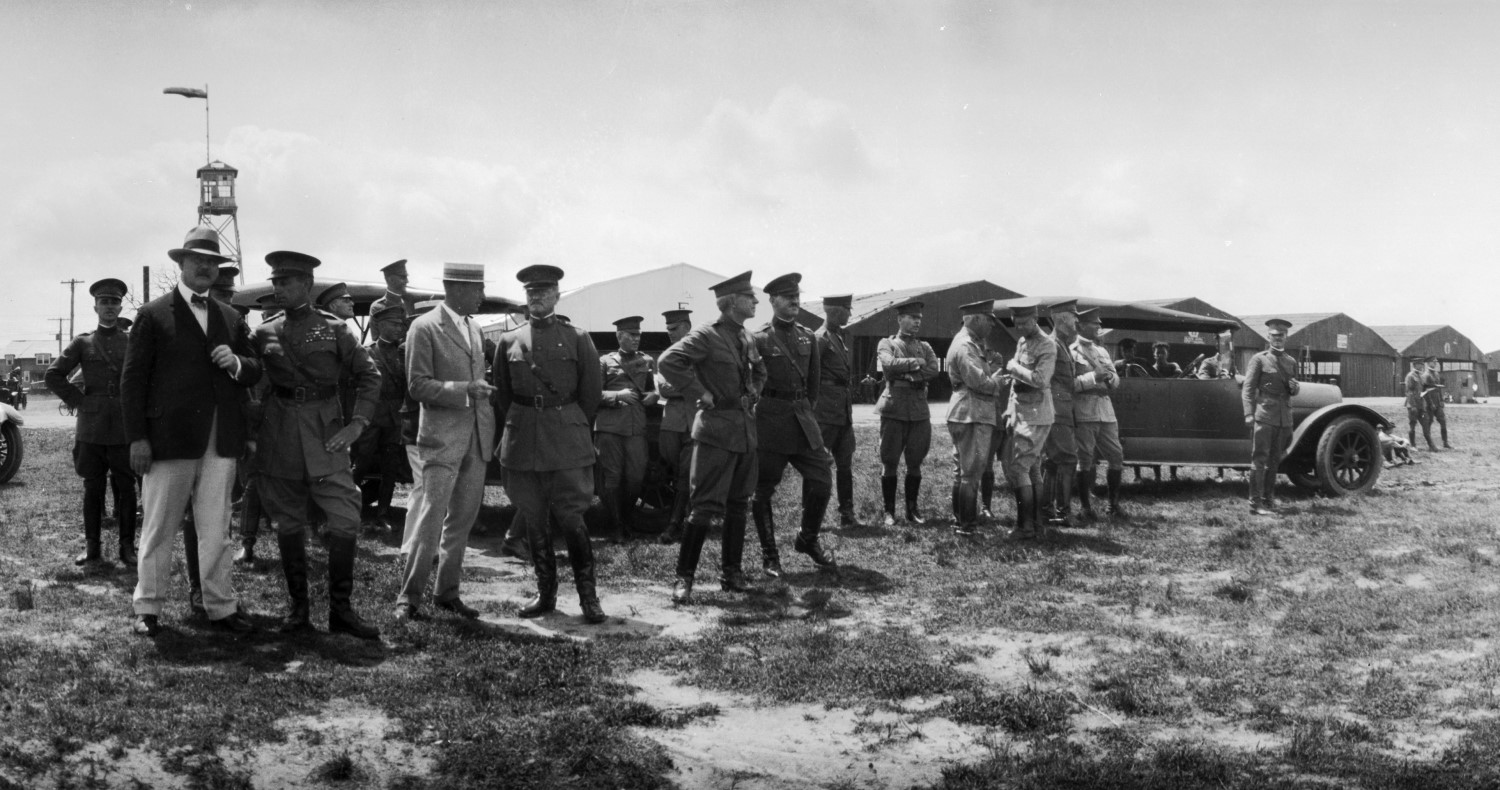
Mitchell shows dignitaries including Weeks and Pershing around before the tests
July 20th dawned with rain and rough seas, which delayed the tests until noon, when the rain had lifted and the seas moderated to allow the observers to go aboard. The first test was supposed to be of armor-piercing bombs converted from 14" AP shells, but it had to be cancelled. The clouds were still too low for the bombs to gain the velocity necessary to punch through the deck, and it was decided to press on with the next round of tests, 33 230 lb bombs dropped by Navy and Marine bombers. Several hit, and as the planes withdrew, the observers went aboard. At 2:05, a message was sent to the Army, authorizing them to take off for their next attack, which would follow a Navy attack with 550 lb bombs. The Army bombers had in fact taken off half an hour earlier, probably on Mitchell's orders but without authorization from the Navy. Mitchell probably feared the weather would close in again and force more cancellations, and he had a long history of disregarding non-flying superiors. Much like during the Frankfort test, the observers were still aboard when the Army bombers arrived, and limited fuel forced the test schedule to be rearranged to let them go first. Only one of the eleven 600 lb bombs struck the ship, although the next wave of Navy bombers did rather better. Four out of eight hit, although several broke up without exploding.
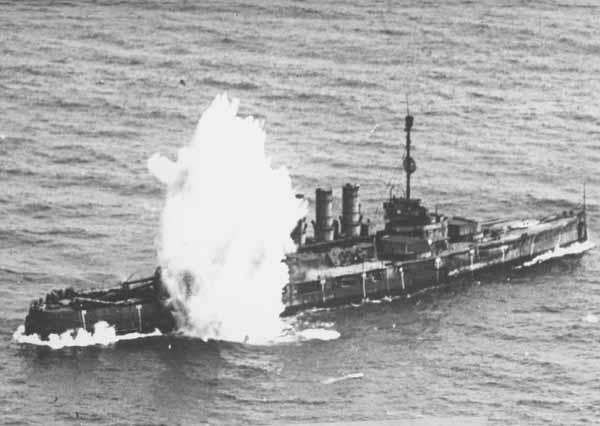
One of the 230 lb bombs hits near Ostfriesland
After the bombers withdrew, the observers went aboard again to give Ostfriesland a through inspection, and found a great deal of damage aboard her. Not from the bombs, which had mostly rearranged the topsides without doing much damage to the ship's combat effectiveness, but from looters. Both Ostfriesland and Frankfort had been sealed up before the tests to give some approximation of watertight integrity, but the crew of the tug had gone aboard looking for souvenirs, and most of the watertight doors had been opened. Some of the observers attempted to seal it up, but they couldn't begin to repair the damage. Some valves had also sprung during the tow to the test site, flooding some of the ship's coal bunkers. The observers also found a ruptured seam in the forward boiler room, which was letting in a great deal of water, and causing the ship to list to port. Patching it was entirely beyond their resources, and when the 22nd dawned, Ostfriesland was on an even keel and down by the stern, with the aft air ports nearly awash. Even if she was not bombed again, her end was clearly near.
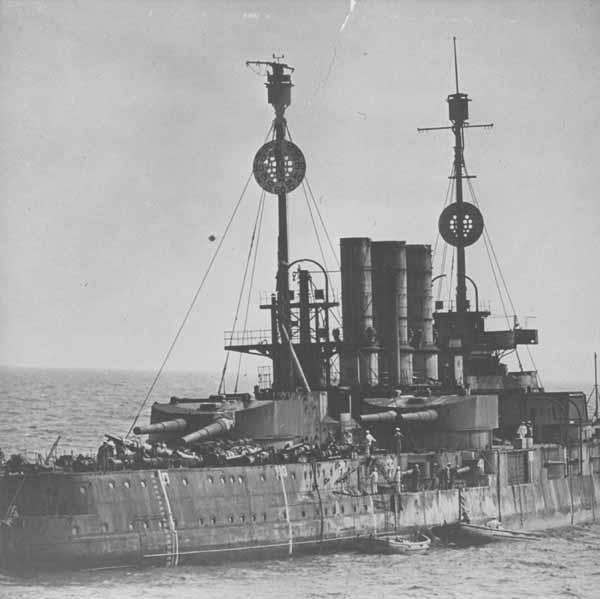
Damage to Ostfriesland on the 21st
The first event of the day was the 1,100 lb bomb test that had been postponed due to weather. Both Army and Navy aircraft took off, but Mitchell, with his usual arrogance, signaled Shawmut requesting that his planes "not be interfered with by Naval aircraft". Half an hour after they arrived over Ostfriesland, one made a hit, which should have prompted a pause in the bombing for the observers to go aboard. Instead, the Army aircraft ignored signals from Shawmut to cease fire, responding that they would let Shawmut know when it was safe to go aboard. Two more hits were made before they agreed to let the inspectors do their job, and the Navy bombers had to return home without making their attacks.

Bombs explode around Ostfriesland
Onboard the battleship, the inspectors found that the three hits had done no serious damage to her combat-effectiveness, but continued flooding had reduced the freeboard aft by another two feet. When they went to check the engine room, they found several feet of water, and bulkheads about to give way. A hasty retreat was made, while Mitchell prepared his pilots for his great publicity coup. The plan called for the Navy to attack Ostfriesland with three 2,000 lb bombs, followed by the Army with three more. Mitchell was unwilling to accept this, and ordered his men to attack first, and to keep bombing until two hits were scored. His message to that effect arrived on Shawmut at the same time as the bombers came overhead, giving the Navy no time to argue. To raise his odds even further, the pilots were ordered to aim for the water near Ostfriesland's side, where the effects of the blast would open her hull plates and put her on the bottom.
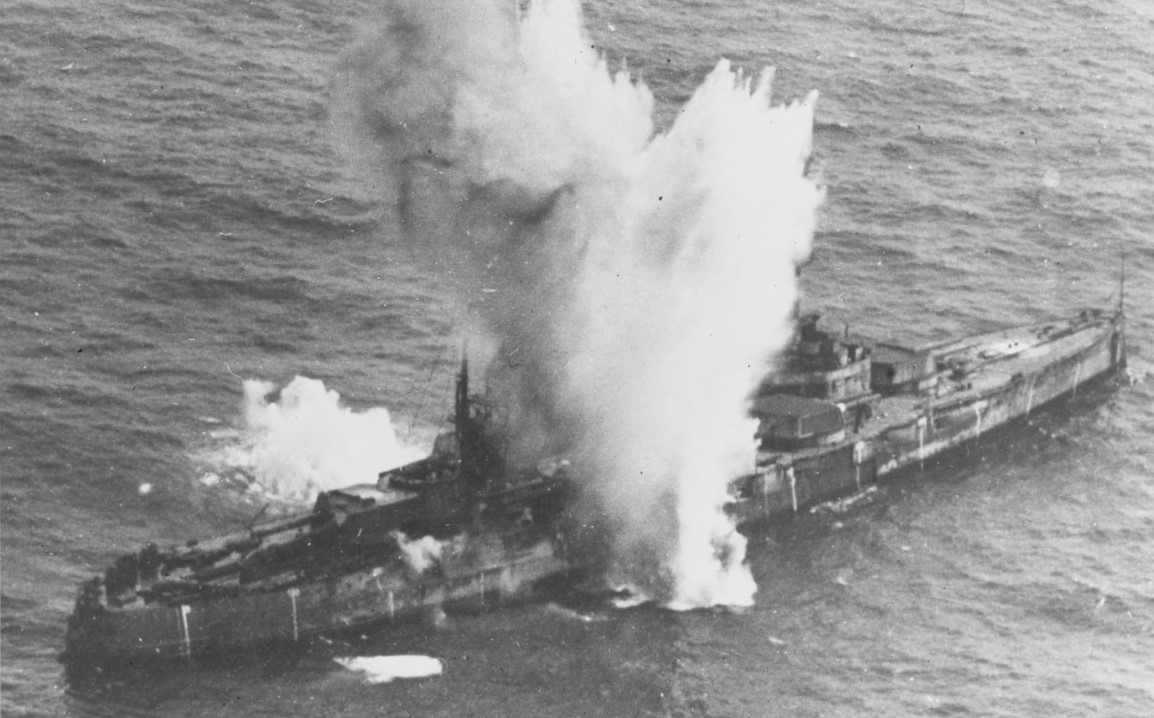
One of the 2,000 lb bombs goes off in the water near Ostfriesland
The first two of the Army's 2,000 lb bombs missed the German battleship, but the third glanced off her port side and exploded in the water. Four more bombs were dropped within the next ten minutes, two exploding close alongside and opening Ostfriesland's hull. Twelve minutes after the first hit, she rolled over and sank. Mitchell's triumph was front-page news across the country, and he was hailed as having proved the battleship obsolete. This was premature, to say the least, and many elements of the Navy were justly furious with him. He had repeatedly disregarded the agreed-upon rules of the test in favor of grandstanding and PR stunts, although his lionization by the press protected him from a well-deserved court-martial. In particular, the AP bomb tests had never been carried out, and under the original rules, the Navy aviators would have been the ones to sink Ostfriesland.
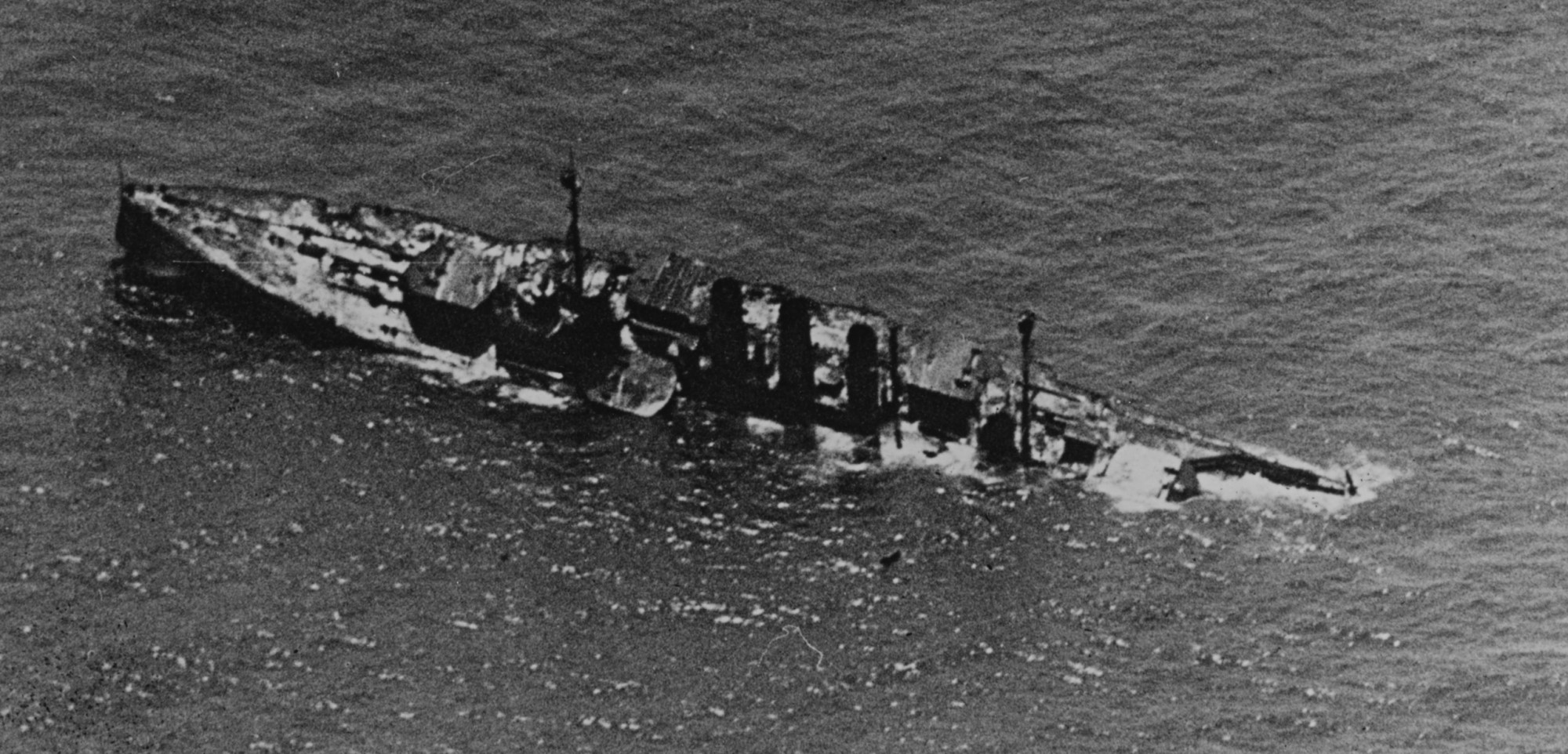
Ostfriesland sinking
But what did the Ostfriesland test actually prove? Even leaving aside the problem of hitting the target, none of the high-explosive bombs did serious damage to the battleship. It certainly looked impressive, but none of the main guns would have been inconvenienced in the slightest, and even most of the secondary weapons were intact. The bigger problem was progressive flooding, primarily due to the complete lack of waterightness. Any competent crew could have easily contained the damage from the first day of bombing, and most likely would have been able to survive the second attack as well.

Sailors watch the bombing test from a nearby ship
Mitchell's claims that the bomber would destroy the battleship proved premature in the extreme. Not only was his victory over the Ostfriesland misleading, but his theories on attacking battleships were entirely wrong. He believed that explosive weight was the most important factor,1 claiming that a single 2,000 lb bomb would be enough to put a battleship out of action.2 This went directly against the test results, which generally showed that HE bombs were ineffective against armored portions of the ship, (nearly all of the important parts on a battleship). The effect of near-miss bombs was another matter, but in that case, the bomb works much like a mine, and protection against mines had greatly improved in recent years. Ultimately, when war gave an opportunity for Mitchell's theories to be tested, it turned out, despite 20 years of progress, that the battleship was surprisingly resilient, and difficult for airplanes to sink.

A white phosphorus bomb goes off above Alabama
Mitchell took his newfound celebrity to heart, continuing his campaign for a stronger Air Force. His report on the tests, sharply at odds with the official version, was leaked to the New York Times, and the head of the Air Service, Charles Menoher, resigned due to his inability to keep Mitchell in line. The pre-dreadnought Alabama was turned over to the Army Air Service for tests in September. Mitchell's first tests were technical in nature, evaluating how smokescreens could be used to protect attacking aircraft from AA gunners, and how white phosphorus and tear gas, used to simulate poison gas, worked against the ship. After that, it was time for a repeat of the Ostfriesland test, and the structurally obsolete pre-dreadnought sunk quickly. Ultimately, the test produced some striking images, but no new information on the problems of sinking ships from aircraft.

Alabama burns, with the hulks of Indiana and San Marcos (ex-Texas) in the background
While the Ostfriesland test had been a major victory for Mitchell, the war wasn't over. The battleship-building program he was so opposed to was indeed killed, not by the airplane, but on the treaty table in Washington. This laid the groundwork for the best aircraft vs battleship test of the era, against USS Washington. Washington, one of the Colorado class, was 75% complete, and unlike Indiana, Ostfriesland, or any of the other battleships attacked, she was representative of the latest in battleship design, particularly in the area of torpedo defense systems. A test with three 1000 lb charges simulating bombs and a pair of 400 lb "torpedoes" left Washington afloat for three days in heavy seas despite the lack of damage control. Another, with a 1,444 lb AP bomb, was stopped by the armored deck. Eventually, she was sunk by gunfire from Texas, and the observers considered the test to have shown that capital ship shellfire remained more dangerous than bombs. Mitchell was not invited to the trials, even as an observer, which allowed him to ignore this trial in his public polemics despite seeing reports.
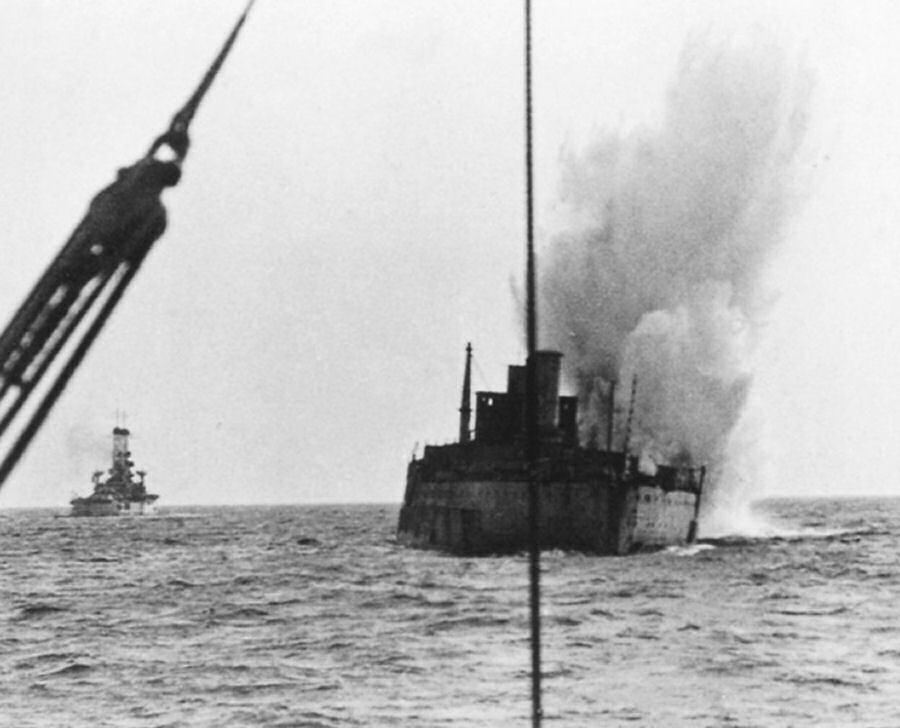
Washington under fire from Texas
1922 saw a cooling of the war between the services. Michell had scored a major victory by sinking Ostfriesland, but the Navy had manage to blunt the worst of his attacks. The Air Service remained part of the Army, and Mitchell was not appointed its chief. His personal life became unstable due to his heavy drinking, to the point that he wounded his wife with a pistol. They swiftly divorced, but Michell's volatile personality would be his downfall when the subject of a unified air service was reopened, a subject we will pick up next time.
1 This belief turned him against torpedoes, which he saw as an inefficient because they contained a lower percentage of explosives by weight than bombs. In fact, by delivering explosives where they were most effective, torpedoes were generally better at killing ships than bombs were. ⇑
2 This seemed to be based on the experience of Derfflinger at Jutland, hit by 17 heavy shells. The total explosive involved was about 1,000 lb, but very little penetrated the German ship's armor due to bad shells. The mind boggles at using this as the basis for analysis. ⇑

Comments
Great post Bean. Always wondered about the whole process of these tests. Good to get the clarity you are giving the subject.
Any chance the sinking of the USS America will end up on this site? Probably confidential but figured I would ask.
I don't really have much information on the America Sinkex, for obvious reasons. If I were to get some worth talking about, I would absolutely cover it, but my interests lie elsewhere at the moment.
Can you post your sources for this post? I'm very curious in the description of the damage from looters.
Most of this came from the book Billy Michell's War With the Navy (USNI, should be on sale from them now), although I think I also went through some of the reports on history.navy.mil. Can't think of anything else at this remove.